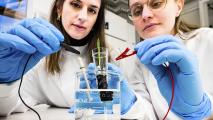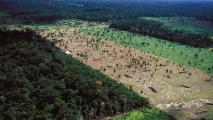This startup wants to track soil carbon with AI and satellites
Carbon credits are currently the subject of heated debate, especially following the October collapse of one of the world’s largest offset experiments, the Zimbabwe Kariba project. Trusted credits are now in high demand, but the steps to qualify to sell them can be costly, preventing many small farmers — who could potentially be paid for changes on their land that remove carbon from the air — from taking part.
Enter Boomitra, an agricultural technology startup that’s rethinking how we track CO2 beneath the Earth’s surface.
The challenge, and the idea: Measuring, reporting, and verifying credits, or what’s known as MRV, requires farmers to manually collect continuous data on their land to measure levels of carbon in the soil over time. With the time and effort this takes, farmers may skip the “convoluted, burdensome and unpredictable” carbon offset process altogether. Overall, the system “has proven difficult and nuanced,” says Columbia Climate School’s State of the Planet.
Remote monitoring could cut the cost of measuring soil carbon by more than 90%.
Boomitra
But what if we didn’t have to physically collect soil samples? Over the years, international foundations like ISRIC have built up extensive databases of soil samples, which can be combined with satellite imagery to monitor soil carbon remotely — no extensive manual labor required.
When scaled “a hundredfold,” says Aadith Moorthy, Boomitra’s CEO, this technology could make global carbon finance more accessible “to all farmers and ranchers, from half-acre smallholder farms to large ranches.”
How it works: Boomitra integrates “an archive of [more than a million] soil samples” and imagery from 100+ multispectral satellites to accurately model 5 million acres of global crop and farmland. The startup’s machine learning models then analyze levels of carbon in the soil over time, helping farmers qualify for third-party-verified carbon credits. Meanwhile, farmers can use Boomitra’s app to track critical soil markers like moisture and nutrients.
Remote monitoring is a little bit like a jigsaw puzzle, in which you fit together different pieces of information to see the full picture, but it could cut the cost of measurement, Boomitra claims, by more than 90%.
The startup, which works with partners like the World Economic Forum, AWS, and Mercy Corps, sends income from selling these credits back to its network of 150,000 farmers and ranchers.
“At Boomitra, we believe carbon storage in soil is vital not only for the carbon markets, but also for climate resilience and achieving food security.”
Aadith Moorthy
Note that Boomitra’s carbon credits are removal credits (which make up only 3% of the world’s carbon credits), not “avoidance” credits (which controversially rest on claims about carbon not being emitted that otherwise would have been). Carbon is physically taken out of the atmosphere and stored in the land, theoretically making removal credits more attractive and reducing the chance that a company will end up on what MIT Technology Review calls “the wrong end of a Guardian, Bloomberg, or New Yorker greenwashing exposé.”
This is important. Businesses are increasingly willing to pay more for higher-quality, assured carbon credits, ones that can show they don’t take advantage of indigenous communities or exaggerate, over-estimate, or fabricate their data on carbon removal.
“[The value of carbon credits],” Moorthy explains, was “one of the hottest topics at COP28.” Even though it’s not a substitute for major cuts to emissions, he adds, the Voluntary Carbon Market remains “one of the best ways to transfer resources … to the developing world.”
It’s not just about tech: Interestingly, Moorthy makes the case that scaling Boomitra’s solution isn’t just a technological change — it’s psychological. For farmers living on the brink, after all, a single setback can have devastating effects. Moorthy recalls being particularly struck by the funeral of a farmer who, after losing everything during monsoon season, took his own life.
“Farming is a hard business … When a farmer or rancher signs up to work with Boomitra and our partners, we shoulder some of that risk for them. We give them the support and knowledge they need to undertake such big changes.”
Aadith Moorthy
Maybe the biggest lesson for startup founders is this: for individuals facing financial insecurity, changing anything about the way you operate can feel like a risk. Boomitra’s multispectral satellites sound a lot closer to technology than culture, but the success of the project, and of precision agriculture in general, will depend on whether farmers feel threatened by new technology — or whether they feel like it better equips them to deal with an unpredictable climate.
Broadening the scope: Now, Boomitra is just one of a growing array of startups using data to help farmers adapt to changing crop yields, temperatures, and growing seasons. By 2027, the market for precision agriculture is predicted to surpass $14 billion.
“My hope,” says Moorthy, “is that Boomitra will help reduce suffering and increase health across the world — starting with the people who feed us.”
We’d love to hear from you! If you have a comment about this article or if you have a tip for a future Freethink story, please email us at [email protected].






